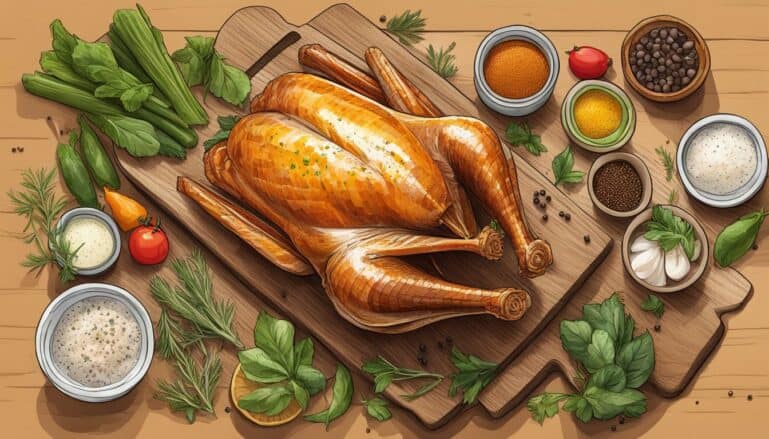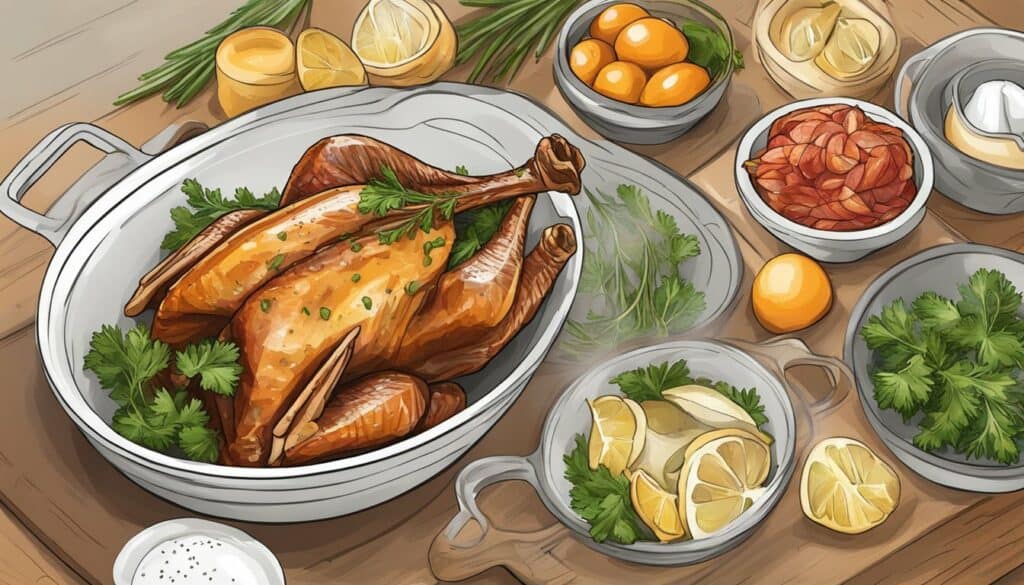How to Cook Turkey Wings: A Step-by-Step Guide

Table of Contents
Choosing the Right Turkey Wings
When it comes to cooking turkey wings, choosing the right type of wings is crucial. Here are a few things to consider when selecting turkey wings:
-
Dark meat vs. white meat: Turkey wings are dark meat, which means they have a richer, more intense flavor than white meat. If you prefer a milder flavor, you may want to opt for turkey legs or breast meat instead.
-
Nutrition: Turkey wings are a great source of protein, with a 3-ounce serving containing around 20 grams of protein. However, they are also higher in fat and calories than other cuts of turkey, so it’s important to keep portion sizes in mind.
-
Drumette vs. wingette: Turkey wings are made up of two parts: the drumette and the wingette. The drumette is the meatier part of the wing, while the wingette is smaller and has less meat. Consider which part you prefer when selecting your wings.
When shopping for turkey wings, look for fresh, high-quality wings that are free from any signs of spoilage. If you’re unsure about which type of wings to choose, don’t hesitate to ask your butcher for recommendations.
Overall, choosing the right turkey wings is an important step in creating a delicious and satisfying meal. By considering factors such as flavor, nutrition, and cut, you can ensure that your turkey wings turn out perfectly every time.
Preparation before Cooking
Before cooking turkey wings, it is important to prepare them properly. Here are the steps I take to ensure my turkey wings are ready for cooking:
- Wash the turkey wings thoroughly with cold water to remove any dirt and debris.
- Pat dry the turkey wings with paper towels to remove any excess water.
- Prep the turkey wings by removing any excess fat or skin.
- Make sure you have all the necessary ingredients on hand before starting to cook.
By following these simple steps, you can ensure that your turkey wings are clean, dry, and ready to be cooked to perfection.
Seasoning the Turkey Wings
When it comes to seasoning turkey wings, there are two approaches: basic and advanced. Both methods can yield delicious results, but the advanced seasoning method can take the flavor to the next level.
Basic Seasoning
For a simple yet flavorful seasoning, start by rubbing the turkey wings with a mixture of kosher salt, black pepper, garlic powder, and onion powder. Then, add a sprinkle of paprika and cayenne pepper for a touch of heat. Drizzle the wings with oil to help the seasoning stick and bake in the oven until golden brown and crispy.
Advanced Seasoning
To take your turkey wings to the next level, try using a blend of herbs and spices. Combine sage, thyme, garlic powder, onion powder, paprika, and cayenne pepper. For a Cajun twist, add some Cajun seasoning to the mix. Rub the seasoning all over the turkey wings and let them marinate in the fridge for a few hours to allow the flavors to penetrate the meat. Drizzle with oil and bake in the oven until crispy and delicious.
When it comes to seasoning turkey wings, the possibilities are endless. Experiment with different herbs, spices, and seasonings to find your perfect flavor combination.

Marinating the Turkey Wings
When it comes to cooking turkey wings, marinating them is a crucial step that can make all the difference in the flavor and tenderness of the meat. Here are my tips for marinating turkey wings to perfection:
-
Start with fresh, high-quality turkey wings. Look for wings that are plump and juicy, with no signs of freezer burn or discoloration.
-
Choose a marinade that complements the natural flavor of the turkey wings. I like to use a mixture of oil, vinegar, and spices, but you can experiment with different ingredients to find your favorite flavor profile.
-
Place the turkey wings in a large plastic bag or shallow dish, and pour the marinade over them. Make sure the wings are fully coated in the marinade, and then seal the bag or cover the dish with plastic wrap.
-
Refrigerate the turkey wings for at least 2 hours, or up to overnight. This will give the marinade time to penetrate the meat and infuse it with flavor.
-
When you’re ready to cook the turkey wings, remove them from the marinade and discard any excess liquid. Pat the wings dry with paper towels to remove any excess moisture.
-
Season the turkey wings with additional spices and herbs, if desired, and then cook them according to your preferred method.
By following these simple steps, you can create delicious, juicy turkey wings that are bursting with flavor. So go ahead and experiment with different marinades and seasonings to find your perfect recipe!
Baking the Turkey Wings
As an alternative to frying, baking turkey wings is a healthier option that still results in crispy and delicious wings. Follow these steps for perfectly baked turkey wings:
Preheating the Oven
Preheat the oven to 375°F (190°C) and position a rack in the center of the oven.
Baking Dish Preparation
Line a baking dish with aluminum foil for easy cleanup. Lightly coat the foil with cooking spray or oil to prevent the wings from sticking.
Baking Process
Arrange the turkey wings in a single layer in the baking dish. Brush the wings with oil or melted butter and season with salt, pepper, and any other desired seasonings. Bake the wings for 45-50 minutes, turning them over halfway through the cooking time. The wings should be golden brown and crispy on the outside.
Checking the Doneness
Use a meat thermometer to check the internal temperature of the wings. The temperature should be at least 165°F (74°C) to ensure that the wings are fully cooked. If the wings are not yet at the desired temperature, continue baking them in 5-minute increments until they reach the correct temperature.
Baked turkey wings are a healthier alternative to fried wings and can be just as delicious. With this simple recipe, you can enjoy crispy and flavorful wings without the extra calories.
Making the Gravy
To make the gravy, I start by pouring the pan drippings into a measuring cup. Then, I add enough turkey broth to make 2 cups of liquid.
Next, I melt 4 tablespoons of butter in a saucepan over medium heat. Once melted, I add 1/4 cup of finely chopped onion and 1/4 cup of finely chopped celery. I let them cook until they are soft and translucent.
Then, I add 1/4 cup of flour to the saucepan and stir it in until the mixture is smooth. I cook the flour mixture for about 2 minutes, stirring constantly.
After that, I slowly pour in the turkey broth and pan drippings mixture, whisking constantly to prevent lumps from forming. I bring the mixture to a simmer and let it cook for about 5 minutes, stirring occasionally.
Finally, I season the gravy with salt and pepper to taste. If the gravy is too thick, I add water or chicken broth, a little at a time, until it reaches the desired consistency.
Here are some tips to make the perfect gravy:
- Use a fat separator to remove excess fat from the pan drippings before making the gravy.
- If you don’t have turkey broth, you can use chicken broth or water instead.
- Be sure to whisk constantly when adding the liquid to the flour mixture to prevent lumps from forming.
- Adjust the seasoning to your taste and add more salt or pepper if needed.
Serving Suggestions
When it comes to serving turkey wings, there are a variety of delicious options to choose from. Here are a few serving suggestions to make the most out of your turkey wings:
-
Serve with a side of mashed potatoes: Turkey wings pair perfectly with creamy mashed potatoes. The combination of savory and creamy flavors is sure to satisfy your taste buds.
-
Add some roasted Brussels sprouts: Roasted Brussels sprouts make a great side dish to turkey wings. The nutty and slightly sweet flavor of the Brussels sprouts complements the rich flavor of the turkey wings.
-
Drizzle with sauce: A delicious sauce can take your turkey wings to the next level. Try a classic gravy or a tangy cranberry sauce to add some extra flavor.
-
Serve as an appetizer: Turkey wings can also be served as a delicious appetizer. Simply cut the wings into smaller pieces and serve with a dipping sauce.
No matter how you choose to serve your turkey wings, they are sure to be a hit at your next meal.

Storing and Reheating
When it comes to storing and reheating turkey wings, there are a few things to keep in mind to ensure the best results. Here are some tips:
-
Reheating: To reheat turkey wings, place them in the oven at 350°F for about 10-15 minutes until they are heated through. You can also reheat them in the microwave, but be sure to cover them with a damp paper towel to prevent them from drying out. If you’re using a slow cooker, add a bit of chicken broth or water to keep them moist while reheating.
-
Freezing: If you have leftover turkey wings, you can freeze them for later use. To do so, let them cool completely, then place them in an airtight container or freezer bag. They will keep in the freezer for up to 3 months. When you’re ready to use them, thaw them in the refrigerator overnight, then reheat using one of the methods mentioned above.
-
Leftovers: If you have leftover turkey wings that you don’t plan on freezing, be sure to store them in an airtight container in the refrigerator. They will keep for up to 3-4 days. When reheating leftovers, be sure to use a food thermometer to ensure that they reach an internal temperature of 165°F.
Overall, storing and reheating turkey wings is a simple process as long as you follow these basic guidelines. By doing so, you can enjoy delicious and tender turkey wings any time you want!
Nutritional Information
When it comes to cooking turkey wings, it’s important to consider the nutritional value of the dish. Here’s a breakdown of the key nutritional information for turkey wings:
- Calories: A single turkey wing typically contains around 120-150 calories, depending on the size and preparation method.
- Fat: Turkey wings are a relatively high-fat food, with around 7-10 grams of fat per wing. However, much of this fat is unsaturated, which can be beneficial for heart health.
- Sodium: Depending on how the wings are seasoned and prepared, they can be high in sodium. It’s important to be mindful of your sodium intake, especially if you have high blood pressure or other health concerns.
- Saturated Fat: Turkey wings are relatively low in saturated fat, with around 2-3 grams per wing.
- Cholesterol: Turkey wings are a significant source of cholesterol, with around 60-70 milligrams per wing.
- Iron: Turkey wings are a good source of iron, with around 1-2 milligrams per wing.
- Calcium: Turkey wings are not a significant source of calcium.
- Potassium: Turkey wings are a good source of potassium, with around 200-250 milligrams per wing.
- Protein: Turkey wings are a good source of protein, with around 15-20 grams per wing.
Overall, turkey wings can be a nutritious and satisfying addition to your diet when enjoyed in moderation and prepared in a healthy way. Be sure to balance your intake of turkey wings with plenty of fruits, vegetables, whole grains, and other nutrient-dense foods to support optimal health.